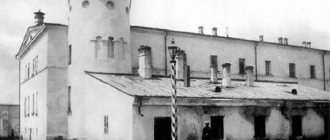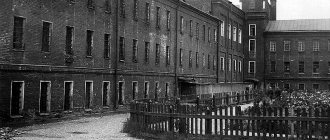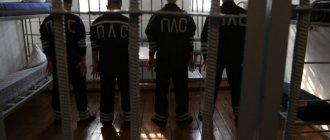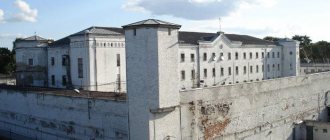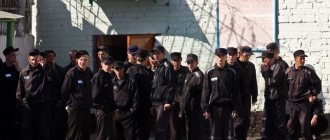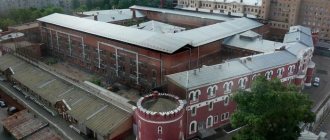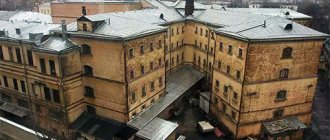general information
- Number of seats: 1220.
- Head of the prison: Alexey Nikolaevich Klimov.
- Phones:
Duty department.Fax - 9.
- What schedule are parcels and letters accepted on?
Monday through FridayApplications are accepted from 8.00 to 12.00.
Reception of transfers - from 10.00 to 15.00.
Short-term visits are provided from 10.00 to 16.00.
- Official website: www.33.fsin.su/structure/t_2_vladimirskiy_tsentral.php
- Official name: T-2 Vladimir Central.
- Address: Russia, Vladimir region, Nizhny Novgorod Bol. st., 67.
Prison on the map:
Who is sitting in the Vladimir Central?
Particularly dangerous repeat criminals are in prison . Often these are the authorities of the criminal world, such as, for example, Sasha Sever.
They say that it was to him that Mikhail Krug dedicated his song “Vladimir Central”, in which these words should have been followed by the phrase “Sasha of the North”.
Subsequently, at the request of his friend Alexander, Mikhail replaced the words “Sasha” with the word “Wind”. It is in this version that the public is familiar with this song.
Familiar faces
At the same time, many believe that Central also has historical significance, because its walls saw the most prominent figures of the Russian revolution: Vladimir Andronnikov, Alexander Shlyapnikov, Mikhail Frunze, Anna Yakimova-Dikovskaya and others.
During the years of the USSR, there were even more political prisoners in this prison. Among them are writers Leonid Borodin and Daniil Andreev, one of the initiators of the Norilsk prison uprising Evgeny Gritsyak, Tajik cultural figure Said Alizade, Georgian democrat Simon Gogoberidze, etc.
Human rights activists and thieves in law were practically in neighboring cells at the Vladimir Central. So, lawyers Egor Davydov and Vladimir Bukovsky served their sentences here, and, for example, Vladimir Babushkin, a thief in law, known in the criminal world as “Vasya the Diamond.”
The Central also hosted famous public and political figures: Prince Pyotr Dolgorukov, Deputy Minister of Internal Affairs of the USSR Stepan Mamulov, popular Hungarian politician Janos Kadar.
People of all stripes
Human rights fighters who were affected by Stalin's repressions were also often sent to the Vladimir Central. So, Kirill Osmak, Mikhail Kukobaka, Alexander Romanov visited the walls of this prison. They were accompanied by former NKVD employees Naum Eitingon and Pavel Sudoplatov.
It is interesting that among the prisoners at Central there were also a variety of cultural figures. For example, folk singer Lidiya Ruslanova was arrested for anti-Soviet propaganda. In addition, the historian Lev Rakov, the French Soviet intelligence officer Jacques Rossi, the actor Sergei Shevkunenko, the Polish partisan Jan Yankovsky, the philosopher Kim Fadeev and the actress Zoya Fedorova, imprisoned for an affair with the American ambassador, were sitting here.
Couldn't do without politicians
It is interesting that figures from the Baltic states were also often imprisoned, and among them were senior political officials, such as: Lithuanian President Aleksandaras Stulginskis, Lithuanian Prime Minister Antanas Merkys along with his son and wife, Foreign Ministers of Lithuania and Latvia Juozas Urbšis and Wilhelm Munters.
Legends in law
Two very common legends are associated with the Vladimir Central. The first is that there was supposedly not a single escape from this prison. The second is that in Vladimir, thieves in law were crowned more often than anywhere else.
Both the first and second are far from the truth. There were escapes, but sooner or later all the escaped prisoners were searched for. As for the coronation, the Vladimir prison has rather become a recognized place for testing future crime lords, although information from current and former operatives about the facts of coronation inside the central prison is quite contradictory. The administration, for example, claims that the idea of the Vladimir prison as an academy for thieves is wrong, and this is understandable: the task of its employees is not to raise, but to debunk thieves in law. However, it was not possible to find out a single fact about the successful debunking of at least one authority.
In the early 80s, especially dangerous repeat offenders from all over Russia were brought to the Vladimir prison, and there was a period when more than two dozen thieves in law were kept there. The current prison staff firmly retains in their memory the most odious names of repeat offenders held in the central prison - 'thieves in law'. Over the past two decades, Vladimir has housed such famous “bubnovi” (that is, Slavic thieves in law) as Brilliant, Shurik Zakhar, Ustimovsky, Uzbek, Lyublinsky, Chizh, Shaky-Bashka, Verevka, Arkan, Kosolapy, Saul, Shket , Walnut, Wallet. And among the “Caucasians”, or “peaks”, they remember Sever, Petso, Tsitska, Kakha, Givi, Roin, Styopa Murmansky, Ogonyok, Nukzar, Boyets, Geno, Zandi, Edik Tbilissky, Ikmet. From Kazan - Farita, Rasp, Red-young.
Thief in law Oleg Shishkanov, nicknamed Shishkan and Oleg Ramensky
As for the coronation of the above-mentioned 'thieves' generals', from a comparison of various information it is obvious that Ogonyok (Alexander Okunev) and Oleg Shishkanov (Shishkan) were crowned in the central office. It is also assumed that the young Redhead was crowned here by Farit, like Bryansky. It is possible that both Lublinsky and Fighter were crowned here. There is information that Red Sr. was crowned by Brilliant.
Vasya Brilliant (Vladimir Babushkin) is considered the most legendary person among the thieves in law who passed through the central prison. Subsequently killed in a zone in the Irkutsk region, he served a long prison sentence in a Vladimir prison in the 1960s and 1970s. Not distinguished by physical strength, he carried out trials and reprisals among prisoners. He skillfully placed the staff in a certain dependence, conveying, for example, through the lads, that the prisoners themselves would punish the cellmate who had unfairly insulted the warden. If he had to talk to the staff, he was reserved and rather dryly polite. He carefully monitored the creases on his trousers and the cleanliness of his boots.
Thief in law Sever (Alexander Severov) served a sentence in Vladimir in the 90s for robbery with a weapon. Before the transfer to Yaroslavl, he presented Nikolai Modestov’s book “Gangster Moscow” to the prison - he was sent two copies to the prison. The dedicatory inscription reads: 'For the long memory of the Vladimir Central, where Thief 'North' Sasha served his term.' Thief in law Shurik Zakhar (Alexander Zakharov), who claims to be the leader in the criminal world, has been released from Vladimir prison. His authority among prisoners is evidenced by the fact that he could enter any cell. Shurik Zakhar behaved more aggressively than Brilliant, and often ended up in a punishment cell, where he spent up to 15 days.
Ustimovsky (Alexander Alyatin), who was released in 1992 and later died of cirrhosis of the liver, according to the recollections of his employees, constantly made instant moonshine - “five-minute”. Ustimovsky managed to make it odorless, but so strong that it even burned.
And this year, thief in law Koshel was released from prison - according to operatives, the last thief in law held in a Vladimir prison. What remained were the “prisoners” whom the thieves ordered to look after the gang: now the bulk of the prisoners are sent to prison from the colonies for repeated disciplinary sanctions.
Photo
The following are photos of the prison “Vladimir class=”aligncenter” width=”800″ height=”534″[/img]
Their life and morals
The basis of the prison buildings is made up of three buildings, historically bearing the names 'Polish', 'Central' and 'Single', forming the Latin numeral 'one' in plan. They, like other prison buildings, were connected by covered walkways in the 60s. You can walk through all the prison buildings without ever ending up in the yard. The windows are covered with metal blinds, through which you can only see stripes of the sky. Concrete exercise yards, covered with a thick layer of ice in winter, are the same cells, but without a ceiling: prisoners must be completely isolated from the outside world.
But, despite all the external changes, prison morals are essentially preserved from time immemorial. For example, A.I. Skobennikov, who served a prison term in Vladimir during the years of the first Russian revolution, noted that in the life of prisoners many traditions were preserved, described in Dostoevsky’s “House of the Dead”: old convicts-criminals were called “Ivans”, young ones - “punks” ' or 'rooks'. Since ancient times, the prison has also preserved the custom of making cards and other gambling games with one’s own hands. In the pre-revolutionary Regulations on prison houses, any games among prisoners, as well as smoking tobacco, were prohibited, but current prisoners are also allowed to while away their time playing chess and dominoes. And yet, the prison collection of gambling homemade products is constantly growing. For example, it even contained several decks made from X-ray film and characterized by amazing accuracy of design.
The current dominant features of prison life are not much different from the previous ones: opposition to the administration, struggle for influence, attempts to communicate with the will, communication between cells through “malyava” or “barrel” (sewer system), gambling, storage and distribution of the prison cash fund - “common fund” . And, of course, constant clashes between “diamonds” and “spades” are a long-standing headache for the prison administration and a characteristic feature of the current criminal world. The degree of hostility between them reached such a scale that attempts were even made to dismantle the cell wall in order to get to a representative of another clan, and, as prison operatives are convinced, this confrontation is unlikely to die down in the foreseeable future.
And yet, according to the testimony of old-timers, twenty years ago the situation in prison was much more complicated: the nature of the crimes committed was more serious, morals were more cruel. There were frequent cases of attacks on employees, up to the heads of detachments, and there is no need to talk about fights between cellmates with sharpeners in their hands and the death of prisoners. One of the former prison workers has three wounds from sharpening, another was attacked more than ten times over three decades of service. Over a long period of time, the staff of the central office collected a rich collection of confiscated sharpening points. After all, even the most ordinary nail becomes a deadly weapon: blood does not flow out through a narrow round hole and extensive hematomas become the cause of death. Meanwhile, the guards inside the prison are not allowed to carry firearms (only the sentries on the towers and the riot policemen on armored personnel carriers on duty in the yard are armed with them), and batons began to be used only in recent years.
On the other hand, according to the central administration, tensions within the prison population were somewhat lower than they are today, primarily because the prisoners were employed in production. Every year the prison had a profit (at old prices) of up to 17 million rubles. Although even then the thieves in law did not work, but they did not give ordinary “men” a break. Under such “control”, instead of one stator winding as required, each member of the brigade wound four, sometimes reaching the point of dystrophy, although, of course, no one was given the Hero of Socialist Labor badges. And the current difficulties of the administration are largely connected precisely with the sharp reduction in the production base: in the former production building there is now a gym and a recreation room for employees, and visiting rooms for prisoners. As a result, due to decreased profits, the funding allocated to the central government was insufficient, and the administration had problems with bed linen, mattresses, clothing for transport, and at one time there were significant shortages of medicines. But in 1992, during the all-Russian protest of prisoners, there were no significant unrest in the central prison.
A little history
This prison can be called one of the most famous. The history of the prison goes back more than 200 years. It begins in 1783. Today, criminals who are recognized as especially dangerous are kept there. But at the very beginning, petty criminals were kept here.
In 1838, instead of a workers' house, a prison company . It was she who became the prototype of the current temporary detention center. It was there that criminals who were sentenced to short terms were kept. They went out to work every day. They were engaged in various socially useful work.
The prison became almost the same as it is now only in 1902. It was then that estimates for the expansion of buildings were approved. According to the project, construction of the second building began. In 1906, this building was called a temporary convict prison. In the early 1920s, the prison became the Vladimir political detention center, and after that it was given the status of a special-purpose prison.
Now criminals who are recognized as especially dangerous are being held here. Criminals from other prisons are also transferred here. Mostly those who end up here are those who have violated the rules of behavior quite strongly in other prisons. Now the walls of the cells are painted in light colors. The cells have a TV and radio.
In 1995, one cell in the prison was converted into a temple. In 2003, a dome was built over the temple. A belfry also appeared in the temple.
The prison has its own production. Vladimir Central is distinguished by its production of sports balls.
Important! In the 1990s, Mikhail Krug often performed at this place.
Background
State houses for keeping criminals in our country appeared 6 centuries ago. True, there were very few of them, since in pre-Petrine Russia the trial was quick, and for many, as they would say today, criminal offenses were immediately deprived of life, flogged with rods or a hand cut off. There were, of course, state criminals who, for one reason or another, were afraid to be executed, fearing popular unrest or based on some other considerations. Such persons, mainly belonging to the royal, princely and boyar families, were forced to take monastic vows and were sent to distant monasteries.
Everything changed during the reign of Catherine the Second, who, among other reforms, carried out changes in the system of punishment for crimes. In 1783, she issued a decree according to which it was prescribed that a criminal who committed petty theft should be punished with whips and placed in “workers’ houses” or, as they were also called, government houses. There they had to work until they had worked off not only the amount of damage caused to the owner of the stolen property, but also another 6 percent on top of that.
To implement the decree, it was necessary to build “workhouses” throughout the country.
Links
- [prisonlife.ru/mesta-lishenya-svobodi/758-vladimirskiy-central-znamenitaya-i-izvestnaya-tyurma-rossii.html#.UWxUqaLIYRo “Vladimir Central” is a famous and well-known prison in Russia]
- [index.org.ru/turma/st/vsetur.htm Directory All prisons in Russia // Material from the analytical weekly Kommersant-Vlast. 17(620) dated 05/02/2005]
- [repressii.avo.ru/index.php?option=com_content&task=view&id=4&Itemid=6 V. Gurinovich. Vladimir prison and political repression]
- [www.rodgaz.ru/index.php?action=Articles&dirid=16&tek=18531&issue=242 Vladimir Central // Rodnaya Gazeta No. 47(133), December 09, 2005]
- [www.rg.ru/2005/10/21/turmi.html V. Kulikov. We sit well // Russian newspaper, 2005. No. 3905]
- [www.virtvladimir.ru/vtown/vladimir/spheres/257/6614 Photo of the administrative building of the prison]
- [www.aferizm.ru/criminal/turma/tyr_remeslo.htm Vladimir Central as a mirror of Russian life]
- [vladimirskij-central.ru/ History of the Vladimir Central]
Schedule
The routine in this prison is not much different from other colonies, although there are some nuances:
- Rise at 6 am by special signal. Lights out at 22. The exception is holidays, when lights out is allowed at 00:00;
- During the day, a walk of one hour is allowed;
- You can visit the recreation room (with TV), chapel and borrow books from the library;
- You can work. About 20% of prisoners work. Those who do not work are kept in cells during the day;
- You can also study, get a vocational or secondary specialized education.
Today, Vladimir Central is one of the most famous Russian prisons, with a long history. But if for museum visitors this is an entertaining excursion, then for prisoners it is a difficult everyday life. Despite fairly modern standards of prison design, being in it is difficult, first of all, psychologically.
Notes
- Central (established) - central prison (Alexandrovsky, Tobolsk, Iletsky, Rizhsky, Nikolaevsky, Novoborisoglebsky, Novobelgorodsky, Orlovsky, Vladimirsky, etc.)
- [www.newizv.ru/news/2004-05-20/6680/ Vladimir Central, money wind // New Izvestia, 2005]
- Rossi J.
Handbook of the Gulag. - T. 1. - M.: Prosvet, 1991. - P. 53. - [www.jacques-rossi-goulag.org/Chronologie.html AAJR - Chronologie]
- [www.zvuki.ru/R/P/75332/ Interview with Simone Salvatori for the music portal “Zvuki.ru”.]
- [vladimirskaya-rus.ru/news/2016-03-21-ufsin-po-vladimirskoy-oblasti-nazval-svoyu-versiyu-sluchivshegosya-vo-vladimirskom-tsentrale.html The Federal Penitentiary Service for the Vladimir Region has given its version of what happened in the Vladimir Central Prison] . Vladimir Rus, March 21, 2016



